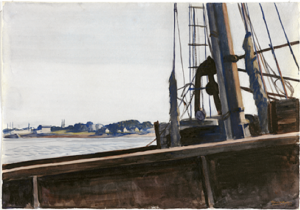Today’s post comes from Michael Reback, Vassar College class of 2011 and Art Center student docent.

I’ve always felt like the parlors on the second floor of Main Building feel a bit more like dioramas than like actual, inhabitable spaces. They are beautiful, certainly, but more than that they feel mysterious, filled with 150 years of history that I know nothing about. Apparently, Martha Kaplan, Professor of Anthropology and Director of Asian Studies at Vassar College, felt much the same way.
For the second lecture in the ongoing Insights on Site series, Professor Kaplan and Adhira Mangalagiri, 2010 Ford Scholar and Vassar College class of 2011, shared their findings from a summer spent researching the decidedly curious Jade Parlor. The Jade Parlor’s predominantly Orientalist décor – seen especially in wallpaper panels in the style of Japanese screens – sets it apart from the Western-centric aesthetic of Vassar College.
The unique nature of the Jade Parlor’s decoration led Professor Kaplan to beg the question – where did this room come from? What was its history? She had hoped, as it were, to demystify the room I’ve always found so enchantingly mysterious. Although Vassar has extensive archives and even an online encyclopedia dedicated to preserving its long history, there was no specific information compiled around the history of the Jade Parlor. Thus, research took the form of digging through archived material, such as Trustees Minutes and back issues of the Miscellany News.
The earliest references to the Jade Parlor refer to it instead as “Room J.” In the early days of the college, when Main Building housed classrooms as well as students, a popular English professor taught in Room J. In 1882, the room was dedicated to use by students, becoming a parlor; later, in 1897 – coinciding with the development of Rockefeller Hall – the Trustees allocated funds to refurnish the parlors in Main. A similar allocation of funds, specifically for Room J, occurred in 1935.
The question remained, though, how the Jade Parlor acquired its Oriental character. In her research, Mangalagiri discovered an early connection between Vassar and Asia – in the 1880s, two Japanese women, Stematz Oyama and Shige Uriu attended Vassar. Another Vassar student, Martha Sharpe, class of 1883, was friends with Oyama and Uriu, and took a trip during her lifetime to visit them in Japan. Later, in 1928, several Asian artifacts were donated to the college from Martha Sharpe’s estate. Whether or not these artifacts came to decorate the Jade Parlor is uncertain, but a clear connection between Vassar and Asia – a mutual connection, in which Vassar was present in Asia and vice-versa – becomes clear.
The Jade Parlor did not reach its current manifestation until 1995, when it was renovated with funds provided by Louise Arias, class of 1962, but we know that Asian-inspired décor furnished the room as early as 1940. The knowledge of a connection between Vassar and Asia, in many ways, informs this room – if not physically, than at least theoretically. Although Orientalism is often characterized as an aesthetic tradition that separates individuals from objects that transforms those objects into curiosities, the Jade Parlor is cemented in a concrete, human relationship between Vassar and Asian culture.




